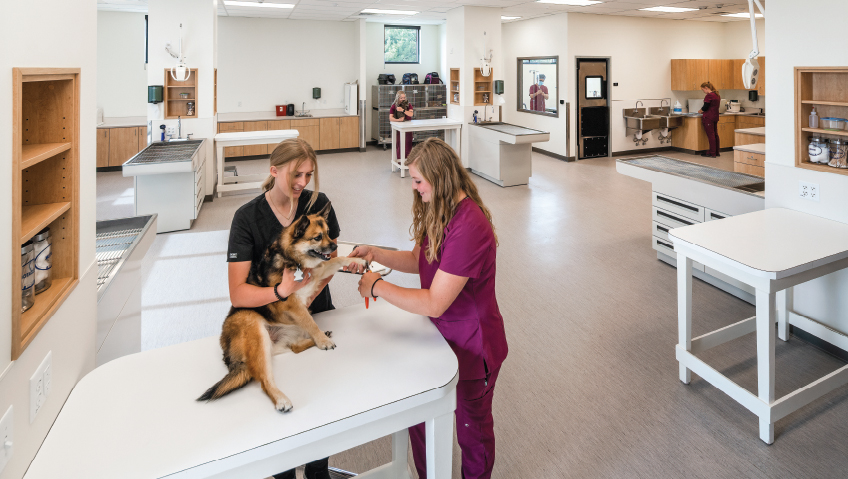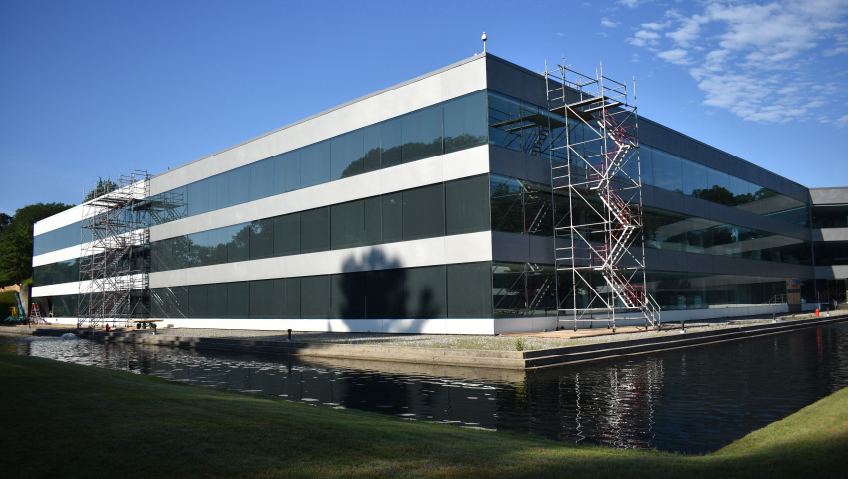When thinking about architecture and building design, we know much time and thought goes into creating sound, healthy, and attractive structures for people, but what about housing for our animal friends? Animal Arts Design Studios specializes exclusively in animal care design, including animal shelters and veterinary hospitals, with a proven track record of success with more than 1,500 projects in 40 U.S. states, Canada, and overseas, ranging in size from 600 to 110,000 square feet.
Founded in 1979 by Lawrence Gates and Mark Hafen, Animal Arts remains a leader in designing healthful environments for animals, taking into consideration the unique needs of shelters to provide care and well-being for animals through innovative designs that incorporate state-of-the-art concepts, materials, and air-handling systems to lower stress, promote comfort, and minimize disease transference.
Winning numerous awards over the years—including 49 Architectural Excellence Awards from dvm360/Veterinary Economics, including the 2022 Hospital of the Year – Ethos VERC, Honolulu, Hawaii, and 2022 Merit Award – Veterinary Clinic of Myrtle Beach, South Carolina, to name just a few—Animal Arts considers not only the animals’ well-being but also the people who tend to them, understanding that performance and productivity are positively impacted by the surrounding environment. To that end, the company’s design aspects embrace sunlight, ventilation, ergonomics, and noise reduction, striving to support clients’ needs and interests while producing innovative and cutting-edge solutions for both humans and animals through ingenuity and creativity.
“Our company provides architectural services, but really we focus exclusively on animal care design,” says Heather Lewis, Principal. “Most people go to architecture school because they want to make a difference in the world, and then you come out of school and it’s hard to make that difference. Animal care is a field where we can do incredible work that has real value, both to individuals and to communities.”
Along with a passion for learning, Animal Arts employs a “relentless” participation in the concerns of the animal care industry, a desire to give back and share knowledge in a way that helps individuals and communities. “We love diving into the details to provide exceptionally useful solutions for our clients,” says Lewis. “By knowing the details, we can strive for the most innovative solutions.”
Dedicated to compassion, collaborative communication, and being accessible, the company is committed to creating humane projects that do no harm.
“We’re all passionate animal lovers here, so we don’t do things like laboratory animal work that conflict with our core values,” says Lewis. “It’s really just focusing on the humane side of animal care, including veterinary hospitals, which have always been our bread and butter.”
The company’s projects range from privately owned hospitals to corporate veterinary hospitals, very small storefronts up to very large specialty hospitals, equine veterinary and animal shelter projects, both privately and publicly funded, service dog training facilities, and university veterinary teaching facilities.
“Animal care has grown tremendously in the last few years, in part because a lot of people got pets during the pandemic, which has had an overall impact on the entire industry,” Lewis says. “Animals have now fully integrated into people’s lives as family members, and we’re doing some really neat things as a result of that.”
The company’s growth has been rapid since the beginning of the pandemic, resulting in taking on larger projects and restructuring to maintain superior customer service. The Arizona Humane Society’s new 65,000-square-foot shelter which just opened in Phoenix is one such notable undertaking.
“One of the neat things about this building is it has an animal trauma hospital,” Lewis says. “They have animal EMTs who are deployed if someone calls and says an animal has been hit by a car. They will go and retrieve them and take them to the trauma hospital for care.”
The thought and planning process that goes into designing animal shelters and hospitals is intricate, beginning with working with the client to help size the veterinary hospital or shelter, ensuring it has the right capacity for animal housing and operations or treatment spaces within it.
“We assist our client from day one on how to help their vision come to fruition,” Lewis says. “Unlike a lot of architecture firms, we’re very heavy on what architects call programming, which is that early planning, and that’s where our expertise is very helpful. That’s a huge part of what we start with.”
The company also brings unique vision, she adds. “We really want to know what that client wants to do from a vision standpoint. We want to make sure this project aligns with the client’s values, that it’s doing what it wants to do in terms of serving the customers that are coming to this building, and that it fits in the community.”
Animal care spaces are highly technical, so Lewis and her colleagues strive to ensure the client can use the facility efficiently from the moment it opens, which involves deep diving into knowledge about all the utilized spaces.
“If it’s a veterinary hospital, we will set up that workstation for the veterinarian to examine a pet. We understand all the things the veterinarian is using, and we’ve envisioned how they get placed in the space,” she says. “We work around the workflow.”
The well-being of the animal is always foremost in their minds, she adds, so one of the most exciting and most passionate things for Lewis is designing around an actual animal and ensuring stress and anxiety are reduced, no matter what building they’re in.
“We also really want to be people-focused, so we’re thinking of all the users of this space,” she says. “Our vision statement is ‘design for every life,’ whether that’s the life of an animal or the life of a staff member working in that building. We’re designing around the occupant, and that’s really where we focus our vision.”
Some unique considerations include designing warm surfaces for cats to lie on to make them happier, more relaxed, and in the case of a shelter situation, ultimately more adoptable. In addition to making spaces animal-centric, Animal Arts also designs them to be human-centric, which means a comfortable work environment, fresh air and daylight, the right ergonomics, and break rooms that provide for a variety of activities and personal needs. “We love designing around the people and the animals. That’s really what motivates us.”
Environmental sustainability is another important motivator. While some areas—California, for instance—already have set a high bar for standards and codes, Animal Arts still pushes itself to higher levels, particularly in terms of energy reductions.
A lot of sustainable design is just good design, she adds, but understanding the client’s needs and desires is always paramount. “That’s where I try to really look at what our clients’ values are and go back to that client-centric approach that we have to find the solutions that make sense for their business or their community.”
Animal care facilities necessitate unique considerations such as adequate airflow to prevent dampness caused by water usage for cleaning, odor elimination, and sanitation. “Animal health care has very high ventilation requirements that sometimes exceed human health care requirements, which is something that most people don’t realize,” Lewis says. “Whenever you’re using a lot of airflow, you’re also using a lot of electricity. So we really focus on energy use reduction with animal care,” she shares.
“One of the things we see in many animal shelter projects is indoor/outdoor spaces for dogs. We might not see that as much in cold climates, but we see it a lot in hot climates. It’s the trickiest and probably the most important thing to design well, because once you cut 20 holes in the building, you have a leaky building that’s very energy intensive. We want to provide indoor/outdoor spaces for the animals, but at the same time put environmental sustainability on the list so the client isn’t paying huge utility bills, and the animals have comfortable spaces.” One solution is designing doors that close after the dog has gone through them to keep air conditioning or heating inside the building.
Air quality and lighting are also environmental design aspects that can greatly affect both animals and humans.
“We might design the entire building to have daylighting so we don’t have to rely as much on artificial lights, and so people can actually see outside, which makes them happier employees,” says Lewis. “It’s known to have really good impact on productivity, so you get a win/win/win: you get daylight, which helps you reduce artificial lighting costs; it helps your employees be happier people; and helps the work be more productive. We’re going to be looking for all these things that unite what we do—what is important to our customers with environmental goals.”
Sound is yet another factor Animal Arts takes into serious consideration. Pets can hear into the ends of the non-audible, ultrasonic spectrum of noise, hearing sounds that humans cannot.
“An animal could be hearing mechanical noise or high-pitched noise made by speakers or lighting fixtures that we’re not even aware of and be stressed by that,” says Lewis. “We look at lighting that eliminates buzz and flicker which will eliminate a lot of those unnecessary visual impacts, as well as noise impacts in the building.”
The company also does a lot of dimmable lighting as animals’ eyes are better at low light levels than humans. Having areas lit like a surgery suite at all times is extremely hard on animals, so in their housing areas the lights can be dimmed down to reduce anxiety and stress.
While taking on new projects and design ideas is exciting, the company’s growth has led to both accomplishments and challenges, particularly in terms of maintaining its focus on customer care.
“We’ve restructured our company to have individual studios inside our larger company that allow us to continue to have that intense customer focus as we grow,” Lewis explains. “We have to continue to be intelligent about how we grow so we don’t get larger than we can handle from an operations perspective and can continue to provide that good customer service, which is really important to us.”
In the coming years, that customer service will involve helping clients do their best work in the animal care space, she adds, along with continuing to lead in animal care by participating with others in the industry who have new ideas, new research, and new knowledge.
Other goals include working with leaders who are trying to address access to care issues, and continuing to participate in thought leadership and work with other people in the industry to make lives better for both people and animals in communities.
“This is a dream job. I love our people. I love that we’ve hired so many people that are so much better at doing things than I am, and that’s the whole goal,” Lewis says. “If you’re a leader, surround yourself with people who are excellent. And we have a lot of excellent people.”






